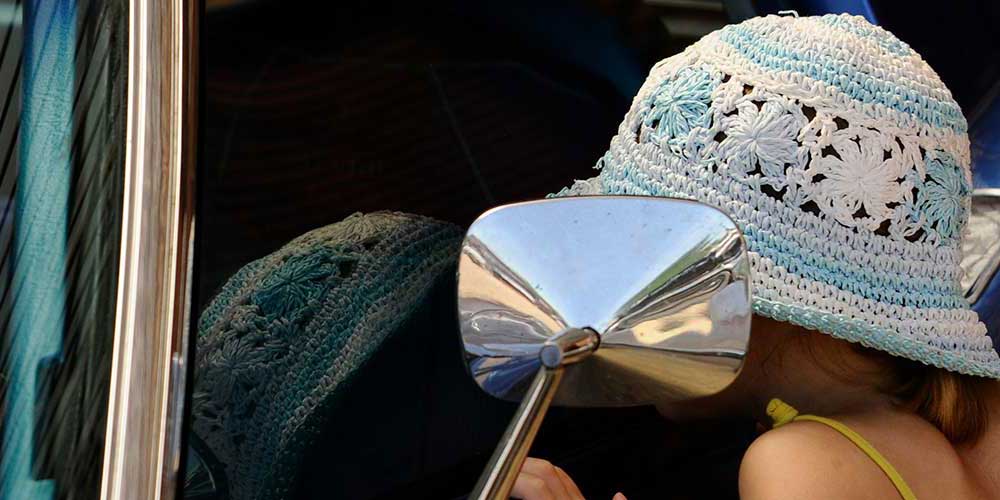by A. Wayne Ferens
Images from the Ferens Collection
Published 9.25.2024
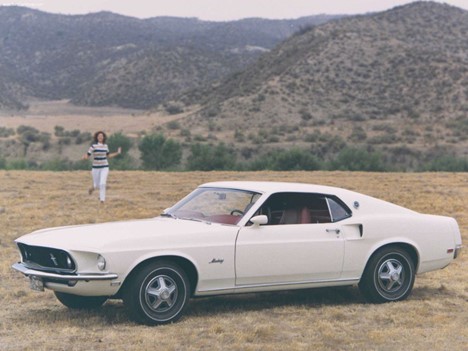 The first Ford Mustang Model E without the rear decal
The first Ford Mustang Model E without the rear decal
As Ford Motor Company's "Total Performance" decade in the 1960s was winding down, was there still room in the trophy case from another motorsport venue?
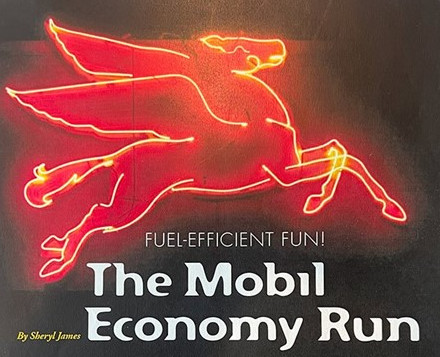
The Mobil Oil Corporation sponsored an annual Mobil Economy Run that was sanctioned by the United States Auto Club (USAC) since 1936 (except during World War II). It was designed to provide real fuel efficiency numbers during a coast-to-coast test on public roads and with regular traffic and weather conditions. The Economy Run became a marketing contest, especially between the “big three” automakers in Detroit. After 1959, cars were judged on an actual miles-per-gallon basis, not ton-miles-per-gallon as in previous contests. The Economy Runs all began in Los Angeles, but the end points varied over the years. In 1962, 1963 and 1967 the event concluded in Detroit with much fanfare from the manufacturers, media, dealers, spectators and advertisers.
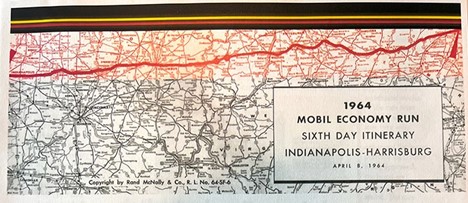 1964 Mobil Economy Run map
1964 Mobil Economy Run map
USAC modified the rules over the years that included eight vehicle classes based on wheelbase, engine and body size as well as price. The automakers provided the drivers. The run included overnight stops and each day’s route was kept secret until the following days start.
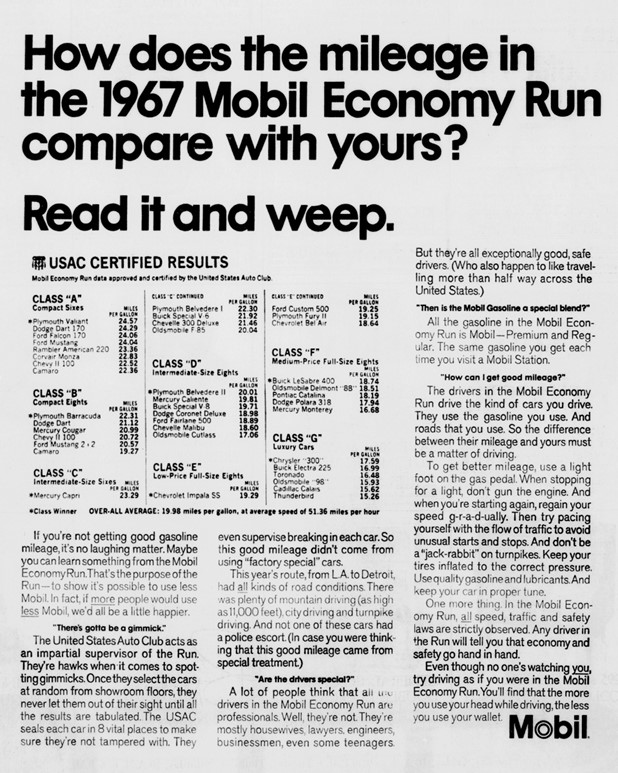 1967 Mobil ad
1967 Mobil ad
It was not unusual for over 50 cars to participate in the Mobil Economy Run with some of the west-to-east coast routes exceeding 2800 miles. Each car had a driver, a relief driver and a USAC observer to prevent any deviations and penalize for any traffic or speed limit violations. Women were permitted to enter the competition in 1957.
The 1969 Ford Mustang body was completely redesigned and included a new SportsRoof model. A total of 299,824 were sold -- over 80 percent with a V8 engine. The most powerful option was the 428 cubic inch 4bbl V8. Later, the Boss 429 V8 was introduced in limited numbers. Ford also offered a base 200ci six, and for the economy minded Mustang owner, a 250ci six. Ford wanted to offer a high mileage version of the Mustang with the hopes of entering the 1969 Mobile Economy Run, but it had to be listed as a production model.
Ford’s Engine & Foundry Division was called upon to develop the high-mileage "Thriftpower," which was based on the 250ci (4.1L) inline-six called the 'Special.' It was not available in other models.
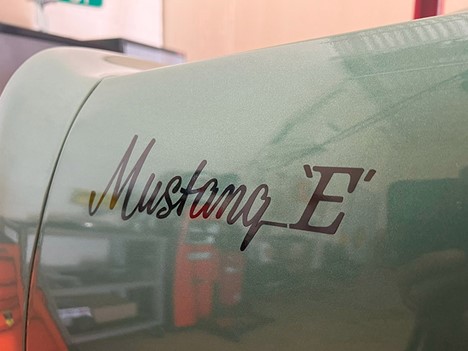 Close up of the Mustang Model E decal. With the exception of Mustang "E" insignia placed on the quarter panels, the styling is identical to other SportsRoof models.
Close up of the Mustang Model E decal. With the exception of Mustang "E" insignia placed on the quarter panels, the styling is identical to other SportsRoof models.
The Thriftpower six was new for 1969 with an increased 9.5:1 compression ratio and a unique single-barrel Autolite carburetor. The only available transmission was a three-speed automatic (C4) equipped with a high stall torque converter and a high 2.33:1 rear axle ratio. It was rated at 155 horsepower and 240 lb./ft. of torque identical to the standard six-cylinder, but the torque converter and revised ratio made it significantly slower. Air-conditioning was not available on the "E" model. Its unique cooling system included a 196-203 degree thermostat, six blade cooling fan (17 inches wide), and a Radiator with 13 fins per inch.
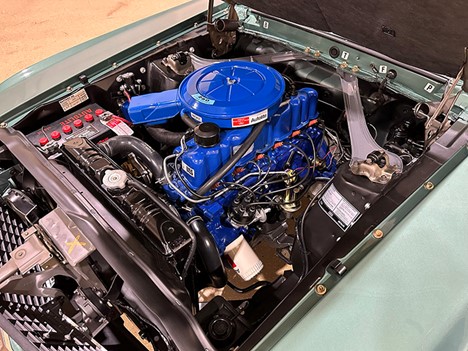 The Mustang E six cylinder engine
The Mustang E six cylinder engine
The Thriftpower 250 six provided 15 percent greater fuel economy than Mustangs with similar drivetrain components. Producing only 96 Mustang "E" models allowed it to be counted as an official production-level automobile. The "E" went from 0 - 60 mph in 13.3 seconds with a top speed of 104 mph. Fuel economy was rated at 19 mpg highway, 13.7 mpg city and 16.3 mpg combined. All "E" models were produced in Dearborn, Michigan.
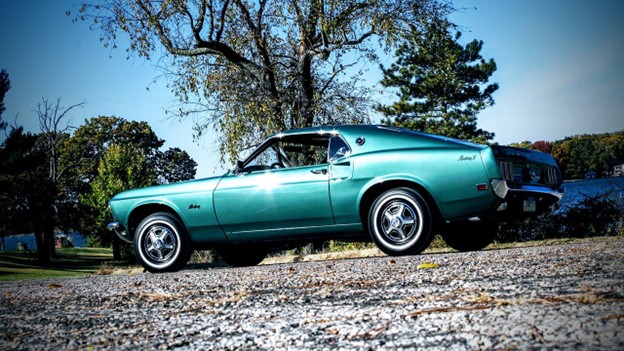 The ultra rare Concours Silver Jade Metallic 1969 Mustang "E" pictured here is VIN 9F02L128388 that was built on November 21, 1968 in Dearborn. It is the only known Mustang "E" in existence. You can't get any more rare than that!
The ultra rare Concours Silver Jade Metallic 1969 Mustang "E" pictured here is VIN 9F02L128388 that was built on November 21, 1968 in Dearborn. It is the only known Mustang "E" in existence. You can't get any more rare than that!
Unfortunately for the Mustang "E", in December 1968, Mobil Oil Corporation’s Vice President of Marketing in North America Robert F. Tucker announced the Mobile Economy Run would be canceled in the United States, citing "changing advertising patterns and changing emphasis in automotive performance” as major factors influencing the decision.
Bibliography:
1969 Ford Mustang Dealer Information.
1969 AMA Specifications AMA-40A
Harmonson, Dave. “The Mobilgas Economy Run.”


